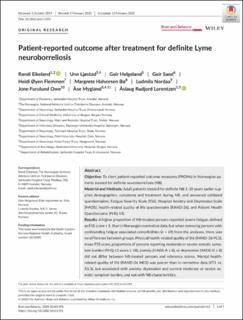| dc.description.abstract | Objective
To chart patient‐reported outcome measures (PROMs) in Norwegian patients treated for definite neuroborreliosis (NB).
Material and Methods
Adult patients treated for definite NB 1–10 years earlier supplied demographics, symptoms and treatment during NB, and answered validated questionnaires; Fatigue Severity Scale (FSS), Hospital Anxiety and Depression Scale (HADS), health‐related quality of life questionnaire (RAND‐36), and Patient Health Questionnaire (PHQ‐15).
Results
A higher proportion of NB‐treated persons reported severe fatigue, defined as FSS score ≥ 5, than in Norwegian normative data, but when removing persons with confounding fatigue associated comorbidities (n = 69) from the analyses, there was no difference between groups. Physical health‐related quality of life (RAND‐36 PCS), mean FSS score, proportions of persons reporting moderate or severe somatic symptom burden (PHQ‐15 score ≥ 10), anxiety (HADS‐A ≥ 8), or depression (HADS‐D ≥ 8) did not differ between NB‐treated persons and reference scores. Mental health‐related quality of life (RAND‐36 MCS) was poorer than in normative data (47.1 vs. 53.3), but associated with anxiety, depression and current moderate or severe somatic symptom burden, and not with NB characteristics.
Conclusions
Results on validated PROM questionnaires measuring fatigue, anxiety, depression, self‐reported somatic symptom burden, and physical health‐related quality did not differ between persons treated for definite NB 1–10 years earlier and reference scores. NB‐treated persons tended to report a slightly poorer mental health‐related quality of life than found in normative data, but when adjusting for confounders the causative connection is questionable. Overall, the long‐term prognosis of definite NB seems to be good. | en_US |

